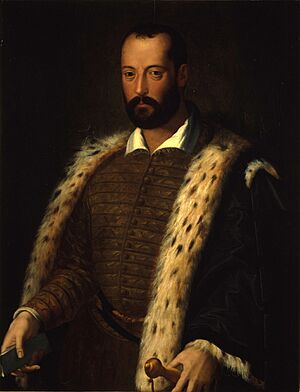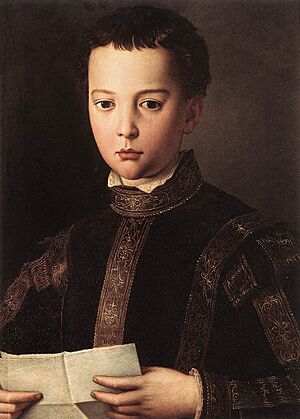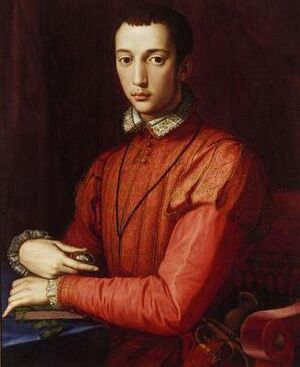Francesco I de' Medici facts for kids
Quick facts for kids Francesco I de' Medici |
|
|---|---|

Portrait by Alessandro Allori, c. 1580-1585
|
|
| Grand Duke of Tuscany | |
| Reign | 21 April 1574 – 19 October 1587 |
| Predecessor | Cosimo I |
| Successor | Ferdinando I |
| Born | 25 March 1541 Florence, Duchy of Florence |
| Died | 19 October 1587 (aged 46) Medici Villa in Poggio a Caiano, Grand Duchy of Tuscany |
| Burial | Cappella dei Principi |
| Spouse | Joanna of Austria Bianca Cappello |
| Issue among others... |
|
| House | Medici |
| Father | Cosimo I |
| Mother | Eleanor of Toledo |
| Religion | Roman Catholicism |
Francesco I (born March 25, 1541 – died October 19, 1587) was the second Grand Duke of Tuscany. He ruled from 1574 until his death in 1587. Francesco was an important member of the powerful House of Medici family.
Contents
Life of Francesco I

Francesco was born in Florence. His parents were Cosimo I de' Medici, Grand Duke of Tuscany, and Eleanor of Toledo. He started helping his father rule Tuscany in 1564, when Cosimo began to step back from some of his duties.
Marriage to Joanna of Austria
On December 18, 1565, Francesco married Joanna of Austria. She was the youngest daughter of Ferdinand I, Holy Roman Emperor. Their marriage was not a happy one. Joanna missed her home in Austria, and Francesco was not always loyal to her.
In 1578, Joanna died at the age of 31. She had fallen down a flight of stairs while pregnant with their eighth child.
His Second Wife, Bianca Cappello
Soon after Joanna died, Francesco married his girlfriend, Bianca Cappello. She was from Venice. Francesco had built and decorated a beautiful place called the Villa di Pratolino for Bianca.
Francesco and Bianca did not have any children together that were considered legitimate heirs. However, Bianca had a son named Antonio from a previous relationship, who Francesco later recognized. Francesco also adopted Bianca's daughter, Pellegrina.
Ruling Tuscany

Like his father, Francesco was a strong ruler. However, he was often seen as less independent than his father. He continued to collect high taxes from his people. This money was often sent to the powerful Habsburg rulers in Austria and Spain.
Francesco was very interested in making things and in science. He started factories for porcelain and stoneware. He also continued his father's support for artists. He built the Medici Theater and helped start the Accademia della Crusca, a famous Italian language academy.
Francesco was also very curious about chemistry and alchemy. He spent many hours in his private laboratory. This special room was called the Studiolo and was located in the Palazzo Vecchio. It held his collections of natural items and stones, where he could experiment with chemicals and try to turn metals into gold.
Death and Legacy
Francesco and Bianca both died in October 1587 at the Medici Villa in Poggio a Caiano. Official records at the time said they died from malaria. However, many people thought they might have been poisoned, perhaps by Francesco's younger brother, Ferdinando.
Later scientific studies in 2010 found evidence of the malaria parasite in Francesco's bones. This strongly supported the idea that they died from malaria, just as the original documents stated. Francesco's brother Ferdinando became the next Grand Duke.
In 1857, the bodies of the Medici family members were moved to their final resting place in the Basilica of San Lorenzo in Florence. A painter named Giuseppe Moricci was there and noticed that Francesco's face looked droopy on one side, and his right hand and leg showed signs of weakness. This suggested he had a stroke sometime before he died. Malaria is known to cause strokes.
There is a famous painting of Francesco as a child by Bronzino that you can see in the Uffizi Gallery in Florence. Francesco's life, especially his marriage to Bianca and their deaths, inspired a play called Women Beware Women by Thomas Middleton.
Children
Francesco and Joanna had eight children:
- Eleonora (1567–1611), who married Vincenzo Gonzaga, Duke of Mantua
- Romola (1568–1568)
- Anna (1569–1584)
- Isabella (1571–1572)
- Lucrezia (1572–1574)
- Marie (1575–1642), who became Queen of France when she married Henry IV
- Filippo (1577–1582)
- A son who died before birth
In Fiction
- Francesco de' Medici appears as a character in the 1612 play The White Devil by John Webster.
See also
 In Spanish: Francisco I de Médici para niños
In Spanish: Francisco I de Médici para niños

